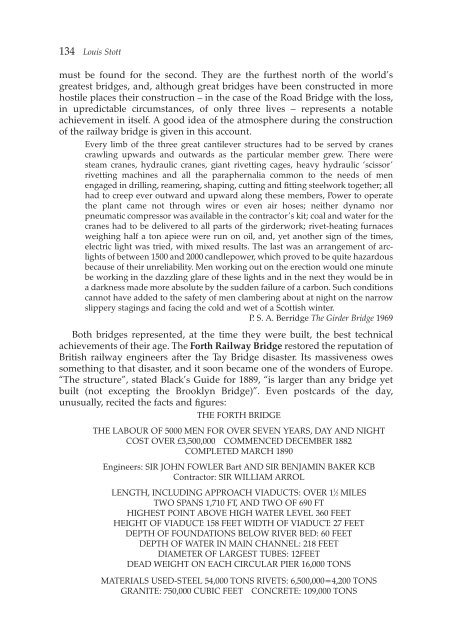the Forth Naturalist Historian - Forth Naturalist and Historian ...
the Forth Naturalist Historian - Forth Naturalist and Historian ...
the Forth Naturalist Historian - Forth Naturalist and Historian ...
You also want an ePaper? Increase the reach of your titles
YUMPU automatically turns print PDFs into web optimized ePapers that Google loves.
134 Louis Stott<br />
must be found for <strong>the</strong> second. They are <strong>the</strong> fur<strong>the</strong>st north of <strong>the</strong> world’s<br />
greatest bridges, <strong>and</strong>, although great bridges have been constructed in more<br />
hostile places <strong>the</strong>ir construction – in <strong>the</strong> case of <strong>the</strong> Road Bridge with <strong>the</strong> loss,<br />
in upredictable circumstances, of only three lives – represents a notable<br />
achievement in itself. A good idea of <strong>the</strong> atmosphere during <strong>the</strong> construction<br />
of <strong>the</strong> railway bridge is given in this account.<br />
Every limb of <strong>the</strong> three great cantilever structures had to be served by cranes<br />
crawling upwards <strong>and</strong> outwards as <strong>the</strong> particular member grew. There were<br />
steam cranes, hydraulic cranes, giant rivetting cages, heavy hydraulic ‘scissor’<br />
rivetting machines <strong>and</strong> all <strong>the</strong> paraphernalia common to <strong>the</strong> needs of men<br />
engaged in drilling, reamering, shaping, cutting <strong>and</strong> fitting steelwork toge<strong>the</strong>r; all<br />
had to creep ever outward <strong>and</strong> upward along <strong>the</strong>se members, Power to operate<br />
<strong>the</strong> plant came not through wires or even air hoses; nei<strong>the</strong>r dynamo nor<br />
pneumatic compressor was available in <strong>the</strong> contractor’s kit; coal <strong>and</strong> water for <strong>the</strong><br />
cranes had to be delivered to all parts of <strong>the</strong> girderwork; rivet-heating furnaces<br />
weighing half a ton apiece were run on oil, <strong>and</strong>, yet ano<strong>the</strong>r sign of <strong>the</strong> times,<br />
electric light was tried, with mixed results. The last was an arrangement of arclights<br />
of between 1500 <strong>and</strong> 2000 c<strong>and</strong>lepower, which proved to be quite hazardous<br />
because of <strong>the</strong>ir unreliability. Men working out on <strong>the</strong> erection would one minute<br />
be working in <strong>the</strong> dazzling glare of <strong>the</strong>se lights <strong>and</strong> in <strong>the</strong> next <strong>the</strong>y would be in<br />
a darkness made more absolute by <strong>the</strong> sudden failure of a carbon. Such conditions<br />
cannot have added to <strong>the</strong> safety of men clambering about at night on <strong>the</strong> narrow<br />
slippery stagings <strong>and</strong> facing <strong>the</strong> cold <strong>and</strong> wet of a Scottish winter.<br />
P. S. A. Berridge The Girder Bridge 1969<br />
Both bridges represented, at <strong>the</strong> time <strong>the</strong>y were built, <strong>the</strong> best technical<br />
achievements of <strong>the</strong>ir age. The <strong>Forth</strong> Railway Bridge restored <strong>the</strong> reputation of<br />
British railway engineers after <strong>the</strong> Tay Bridge disaster. Its massiveness owes<br />
something to that disaster, <strong>and</strong> it soon became one of <strong>the</strong> wonders of Europe.<br />
“The structure”, stated Black’s Guide for 1889, “is larger than any bridge yet<br />
built (not excepting <strong>the</strong> Brooklyn Bridge)”. Even postcards of <strong>the</strong> day,<br />
unusually, recited <strong>the</strong> facts <strong>and</strong> figures:<br />
THE FORTH BRIDGE<br />
THE LABOUR OF 5000 MEN FOR OVER SEVEN YEARS, DAY AND NIGHT<br />
COST OVER £3,500,000 COMMENCED DECEMBER 1882<br />
COMPLETED MARCH 1890<br />
Engineers: SIR JOHN FOWLER Bart AND SIR BENJAMIN BAKER KCB<br />
Contractor: SIR WILLIAM ARROL<br />
LENGTH, INCLUDING APPROACH VIADUCTS: OVER 1 1 ⁄2 MILES<br />
TWO SPANS 1,710 FT, AND TWO OF 690 FT<br />
HIGHEST POINT ABOVE HIGH WATER LEVEL 360 FEET<br />
HEIGHT OF VIADUCT: 158 FEET WIDTH OF VIADUCT: 27 FEET<br />
DEPTH OF FOUNDATIONS BELOW RIVER BED: 60 FEET<br />
DEPTH OF WATER IN MAIN CHANNEL: 218 FEET<br />
DIAMETER OF LARGEST TUBES: 12FEET<br />
DEAD WEIGHT ON EACH CIRCULAR PIER 16,000 TONS<br />
MATERIALS USED-STEEL 54,000 TONS RIVETS: 6,500,000=4,200 TONS<br />
GRANITE: 750,000 CUBIC FEET CONCRETE: 109,000 TONS



